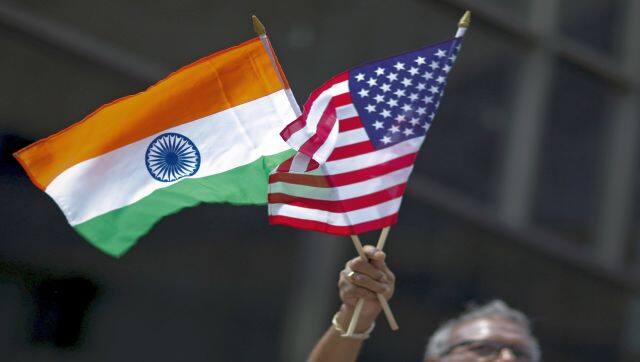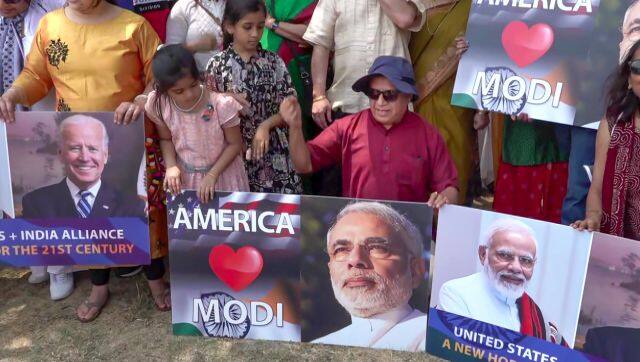“I am confident that my visit to the United States will reinforce our ties based on shared values of democracy, diversity and freedom. Together we stand stronger in meeting the shared global challenges,” said Prime Minister Narendra Modi as he departed for his significant and all-important state visit to Washington on the invitation of President Joe Biden and First Lady Jill Biden.
Modi will be in the US from 21 June – he will lead the Yoga Day celebrations at the United Nations headquarters – until 24 June, holding talks with the US president as well as important members of US society, including addressing a joint session of the US Congress. From Washington, Modi will fly to Cairo until 25 June, where he will reinforce New Delhi’s ties with Egypt. And Washington is rolling out the red carpet for Prime Minister Modi. There’s a state dinner, the Biden administration’s third such visit after welcoming French president Emmanuel Macron and South Korea’s Yoon Suk-yeol within the past year. It’s not just pomp and symbolism, however. The visit is significant for both countries – the US wants to bring India deeper into its manufacturing and defence orbit, with the added benefit of countering China’s growing influence in the Indo-Pacific region. On the other hand, Modi’s visit to Washington will probably also reap big benefits for New Delhi – in defence as well as other sectors like space and technology, and even education.
Here’s a deeper, better look at how Modi’s state visit to the US will benefit India. The big defence deals There are two very big defence deals which are likely to be announced when Prime Minister Modi is in Washington with President Joe Biden. First, is the whopping $3 billion deal for outright purchase of 30
MQ-9 Reaper
or Predator B drones. These drones have the ability of carrying sensors and laser-guided bombs besides air-to-ground missiles. It has an endurance of over 27 hours and can operate up to 50,000 ft with a 3,850 pound (1,746 kg payload capacity that includes 3,000 pounds (1,361 kg) of external stores. Additionally, the Predator B drones are capable of carrying multiple mission payloads, making them dangerous and versatile. As per the US Air Force, the Reaper is capable of employing “eight laser-guided missiles, air-to-ground missile-114 Hellfire, which possess highly accurate, low-collateral damage, anti-armour and anti-personnel engagement capabilities.” This drone deal is important for India as it will enhance the Intelligence-Surveillance-Reconnaissance (ISR) capabilities of India’s armed forces. These drones can facilitate long-range surveillance and strike capabilities both in the Indian Ocean Region (IOR) and on the land borders. An India Today report citing military experts said that the drones would help Indian forces to “launch remote-controlled operations and surgical strikes, such as on terrorist hideouts in Pakistan-occupied Kashmir, and engage targets on the Himalayan borders with China.” [caption id=“attachment_12763242” align=“alignnone” width=“640”] A big part of Narendra Modi’s state visit to the US will focus on defence cooperation between the two countries. File image/Reuters[/caption] Apart from this, there’s also the
jet engine deal
that is likely to be inked between American company General Electric (GE) and India’s Hindustan Aeronautics Limited to co-produce the GE-F414 INS6 engine for India’s indigenous Tejas Mk 2. This deal is noteworthy as transfer of technology in this sphere is rare. In fact, only four countries across the globe that have mastered this technology for the production of combat jet engines – the United States, the United Kingdom, France and Russia. Even China for all its advancements and military prowess, struggles to develop its jet engines for military jets and relies on Russia. According to a report in The Indian Express, India will get at least 11 “major manufacturing technologies” as part of the GE-HAL fighter jet engine deal, which are not readily available in India. These technologies include: special coatings for corrosion, erosion and thermal barrier for hot end; machining and coating for single crystal turbine blades; machining and coating of nozzle guide vanes and other hot end parts; blisk machining; machining of powder metallurgy discs for turbine; machining thin-walled titanium casing; friction/inertia welding for fan & afterburner; PMC (polymer matrix composites) for bypass duct; machining & coating of CMC (ceramic matrix composites) for nozzle; laser drilling technology for combustor; and bottle boring of shafts, sources told Indian Express.
A big part of Narendra Modi’s state visit to the US will focus on defence cooperation between the two countries. File image/Reuters[/caption] Apart from this, there’s also the
jet engine deal
that is likely to be inked between American company General Electric (GE) and India’s Hindustan Aeronautics Limited to co-produce the GE-F414 INS6 engine for India’s indigenous Tejas Mk 2. This deal is noteworthy as transfer of technology in this sphere is rare. In fact, only four countries across the globe that have mastered this technology for the production of combat jet engines – the United States, the United Kingdom, France and Russia. Even China for all its advancements and military prowess, struggles to develop its jet engines for military jets and relies on Russia. According to a report in The Indian Express, India will get at least 11 “major manufacturing technologies” as part of the GE-HAL fighter jet engine deal, which are not readily available in India. These technologies include: special coatings for corrosion, erosion and thermal barrier for hot end; machining and coating for single crystal turbine blades; machining and coating of nozzle guide vanes and other hot end parts; blisk machining; machining of powder metallurgy discs for turbine; machining thin-walled titanium casing; friction/inertia welding for fan & afterburner; PMC (polymer matrix composites) for bypass duct; machining & coating of CMC (ceramic matrix composites) for nozzle; laser drilling technology for combustor; and bottle boring of shafts, sources told Indian Express.
Catch our full coverage of PM Modi in US Yoga, meal with the Bidens, meet with CEOs: PM Modi’s packed days during US visit Modi in US: Why PM’s sixth visit to the US is even more significant than past trips Explained: How Pakistan’s ISI is plotting to disrupt PM Modi’s historic state visit to the US Deals on drones and jets: How India-US defence ties are flourishing under PM Modi Rattled by Prime Minister Modi’s US visit, western media pulls out its template of lies
Visas for Indians Another big boon for India that may come out of Modi’s US visit is the matter of visas for Indians. There are talks that the visa wait time issue that has seen Indians facing a
waiting period
of up to 600 days for the process will be resolved and an announcement on the same would be made during the state visit. India’s Ambassador to the US, Taranjit Singh Sandhu, in an exclusive interview with Business Today said during that Prime Minister Narendra Modi’s maiden state visit to America, there will be discussions on ease of waiting period of visas for Indians and a number of initiatives will also be taken to make the process more seamless. Incidentally, just days before Modi’s visit, the Biden administration eased norms by releasing policy guidance on the eligibility criteria for those waiting for
green cards
to work and stay in America. [caption id=“attachment_12763012” align=“alignnone” width=“640”] Indian-Americans gather to send a message of welcome to Prime Minister Narendra Modi ahead of his state visit, in Washington. PTI[/caption] Boost to trade The US is also likely to ask India to join the trade pillar under the Indo-Pacific Economic Framework (IPEF) during Modi’s visit. For the unaware, the IPEF was launched jointly by the US and other partner countries of the Indo-Pacific region on 23 May in Tokyo. The framework is structured around four pillars relating to trade, supply chains, clean economy, and fair economy. India has joined all the pillars except the trade one. Space ties to get deeper Modi’s US visit will also most likely see a deepening of space-related collaboration. According to some media reports, there will be deeper collaboration on astronaut training, crew rescue, and other activities in human space flight. This would greatly benefit India’s
Gaganyaan mission
. The mission aims at launching a crew of three members to an orbit of 400 km for a three-day mission which is scheduled for 2025. There’s also the possibility of New Delhi’s participation in the Artemis Accords — a multilateral exploration programme led by the US, with the participation of 24 other countries, that establishes a framework for civil cooperation and peaceful use of the moon, Mars and other astronomical objects. Change in US-India ties The bonhomie between Modi and Biden is reflective of the growing ties between India and the US. However, this wasn’t always the case between the two countries. Earlier during the Cold War era, India was more closely aligned with Russia due to US distrust and estrangement over India’s nuclear program, , while the Washington had a stronger partnership with India’s rival, Pakistan.
Indian-Americans gather to send a message of welcome to Prime Minister Narendra Modi ahead of his state visit, in Washington. PTI[/caption] Boost to trade The US is also likely to ask India to join the trade pillar under the Indo-Pacific Economic Framework (IPEF) during Modi’s visit. For the unaware, the IPEF was launched jointly by the US and other partner countries of the Indo-Pacific region on 23 May in Tokyo. The framework is structured around four pillars relating to trade, supply chains, clean economy, and fair economy. India has joined all the pillars except the trade one. Space ties to get deeper Modi’s US visit will also most likely see a deepening of space-related collaboration. According to some media reports, there will be deeper collaboration on astronaut training, crew rescue, and other activities in human space flight. This would greatly benefit India’s
Gaganyaan mission
. The mission aims at launching a crew of three members to an orbit of 400 km for a three-day mission which is scheduled for 2025. There’s also the possibility of New Delhi’s participation in the Artemis Accords — a multilateral exploration programme led by the US, with the participation of 24 other countries, that establishes a framework for civil cooperation and peaceful use of the moon, Mars and other astronomical objects. Change in US-India ties The bonhomie between Modi and Biden is reflective of the growing ties between India and the US. However, this wasn’t always the case between the two countries. Earlier during the Cold War era, India was more closely aligned with Russia due to US distrust and estrangement over India’s nuclear program, , while the Washington had a stronger partnership with India’s rival, Pakistan.
As former US Ambassador, Dennis Kux, stated that the two countries remained “estranged democracies, until the early 1990s. However, since the early 2000s, US administrations from Bill Clinton to Donald Trump have worked to build a strong relationship with India, recognising its potential to be a strategic partner in ensuring the security of the Indo-Pacific region. M R Rangaswami, the founder of Indiaspora, among the most influential global Indian diaspora organisations, was quoted as telling Hindustan Times that equations have changed over the years and now is the time that the US is equally excited to work with India and both sides are keen to achieve substantive outcomes. “Initially, India wanted to do more with the US and there were a lot of expectations on the Indian side. The equation has altered where the US side is equally excited and wants to do stuff. Both sides want to make things happen. Given President Joe Biden’s commitment and the number of ministerial meetings that have happened, it’s clear that both sides want to make stuff happen,” he said. With inputs from agencies Read all the Latest News , Trending News , Cricket News , Bollywood News , India News and Entertainment News here. Follow us on Facebook , Twitter and Instagram .
)